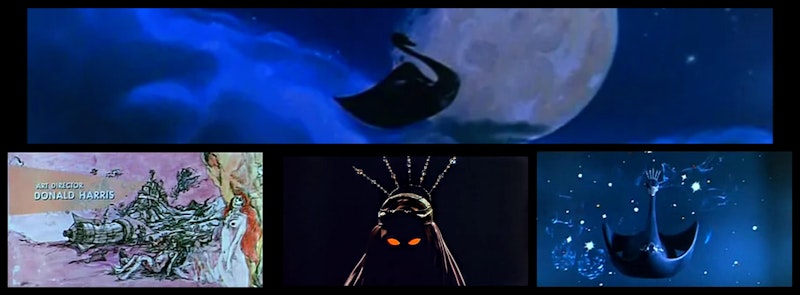In the Irish folk epic Tochmarc Etaine (The Wooing of Etaine) two lovers magically transform into swans as they make a daring escape from the clutches of a jealous king. In Hindu lore the swan’s aerial grace, coupled with its ability to swim, made it synonymous with the bond uniting Earth and the realm of the gods. In ancient Greek mythology the sun god Apollo’s chariot was pulled across the sky by a pair of giant swans. Many other supernatural swans are part of folklore, fine art, and pop culture. They’ve long been a unique element in narratives that involve love, lust, reproduction, commitment, marriage, and other romantic themes.
The swan mystique has been immortalized within all artistic mediums. For better or worse, its most profound celluloid moment survives as part of an obnoxious exploitation work called Flesh Gordon. This satirical sci-fi skin flick was the brainchild of Howard Zeihm and Bill Osco, two auteurs sometimes credited as the founders of America’s legal adult film industry. Flesh Gordon was released in 1974 as an R-rated softcore movie and an alternate triple-X version of it came out later with additional hardcore sequences. The picture has developed a strong cult following thanks to its ludicrous comic strip premise and its post-Barbarella weirdness. The latter element shines thanks to the movie’s warped production design, a hybrid of corny bathroom humor, surrealism, frenetic animation, and hedonistic irreverence.
Donald Harris was the art director responsible for this cracked tableaux. The only other major work he’d done around the same time was a 1977 Donny and Marie episode that included an Osmond Brothers music video, portions of which bear uncanny resemblance to Flesh Gordon’s dreamiest scenes. Regardless of the movie’s vulgarity, Harris’ visuals are never overshadowed. Unfortunately great production design doesn’t always translate to great cinema. It’d be a stretch to say that this sub-National Lampoon campfest is “saved” by Harris, but there’s no doubt that his contributions form the most emotionally powerful element of the picture.
Harris’ visual splendor peaks when the witchy seductive antagonist Queen Amora (Nora Wierternik) magically transports Flesh Gordon's main character (Jason Williams) to the bedroom of her swan-shaped space ship. Lush trippy music resonates as the queen wipes out Flesh’s inhibitions. This happens while she hides within a shadowy veil. Her orange eyes peer out from darkness emitting a fiery glow that puts Flesh into a horny trance. Throughout the sequence the swan ship ascends gently through an animated starscape filled with constellations, clusters, and nebulas that gradually shift in shape and swell with light. The flickering cartoon galaxy is cut with shots of Flesh and Amora lost in passionate embrace. A purple-blue psychedelic glow covers everything, the viewer can see no graphic detail. In addition to co-producing/co-directing the film, Zeihm served as its cinematographer; his impressionistic lens does wonders with a bare minimum of light. Even with two naked blondes gyrating in ecstasy, the raw lust would be worthless without the swan ship’s cosmic ascension.

